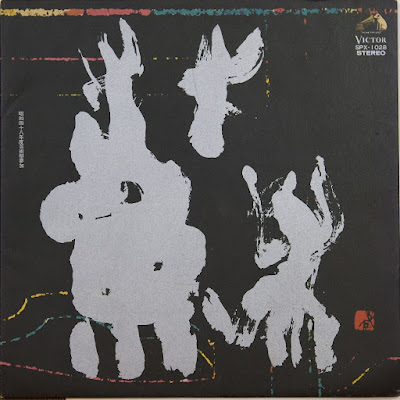Minoru Muraoka & New Dimension
1973
So
01. 韻 (In)
02. 撥 (Bachi)
03. 旋法 (Sempou)
04. 打 (Da)
05. 波響 (Hakyou)
Bass – 佐藤桂吾 (Keigo Sato)
Biwa [Satsuma Biwa] – 平山万佐子 (Keigo Sato)
Koto [Jushichigen Koto] – 中丸春美 (Keijiro Kubota)
Percussion [Tsuzumi], Taiko [Wadaiko] – 堅田喜三久 (Kisaku Katada)
Shakuhachi, Shinobue – 村岡実 (Minoru Muraoka)
Shamisen [Tsugaru Jamisen] – 佐々木壮明 (Somei Sasaki)
Sho, Flute [Hichiriki] – 佐藤要征 (Yosei Sato)
Taiko [Wadaiko] – 堅田啓輝 (Hiromitsu Katada), 安部健二郎 (Kenjiro Abe)
Gatefold cover. Recorded August 13, 14 & 15, 1973.
Shakuhachi master and band leader Muraoka recorded scores of records over the years, covering all kinds of ground, with a focus on integrating the traditional Japanese shakuchachi flute into modern western-style music. His most interesting period (from a rock/jazz listener's perspective) unsurprisingly coincided with the experimental New Rock boom in Japan circa the early/mid 70s. His most well-known works are from earlier on in this timeframe, when he released albums like "Osorezan" and "Bamboo", which have long been popular with the rare groove/DJ crowd. But after this he developed a darker, more experimental streak, releasing a string of albums with his New Dimension Group where he started to twist and mutate traditional Japanese music to his own ends, leading to fascinating efforts such as "Jigen" (1972) and "So" (1973). However, these were still probably too traditional to catch the ear of many prog/psych listeners.
1973
So
01. 韻 (In)
02. 撥 (Bachi)
03. 旋法 (Sempou)
04. 打 (Da)
05. 波響 (Hakyou)
Bass – 佐藤桂吾 (Keigo Sato)
Biwa [Satsuma Biwa] – 平山万佐子 (Keigo Sato)
Koto [Jushichigen Koto] – 中丸春美 (Keijiro Kubota)
Percussion [Tsuzumi], Taiko [Wadaiko] – 堅田喜三久 (Kisaku Katada)
Shakuhachi, Shinobue – 村岡実 (Minoru Muraoka)
Shamisen [Tsugaru Jamisen] – 佐々木壮明 (Somei Sasaki)
Sho, Flute [Hichiriki] – 佐藤要征 (Yosei Sato)
Taiko [Wadaiko] – 堅田啓輝 (Hiromitsu Katada), 安部健二郎 (Kenjiro Abe)
Gatefold cover. Recorded August 13, 14 & 15, 1973.
Shakuhachi master and band leader Muraoka recorded scores of records over the years, covering all kinds of ground, with a focus on integrating the traditional Japanese shakuchachi flute into modern western-style music. His most interesting period (from a rock/jazz listener's perspective) unsurprisingly coincided with the experimental New Rock boom in Japan circa the early/mid 70s. His most well-known works are from earlier on in this timeframe, when he released albums like "Osorezan" and "Bamboo", which have long been popular with the rare groove/DJ crowd. But after this he developed a darker, more experimental streak, releasing a string of albums with his New Dimension Group where he started to twist and mutate traditional Japanese music to his own ends, leading to fascinating efforts such as "Jigen" (1972) and "So" (1973). However, these were still probably too traditional to catch the ear of many prog/psych listeners.
